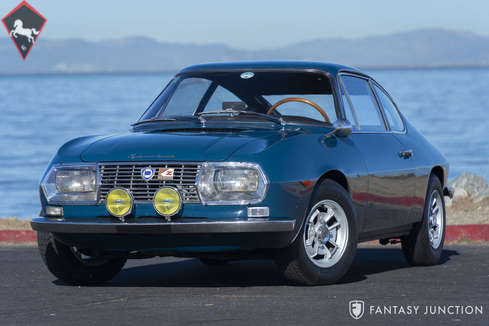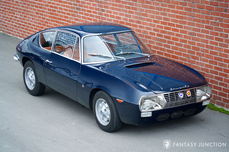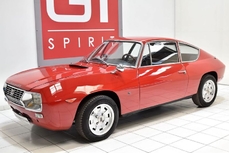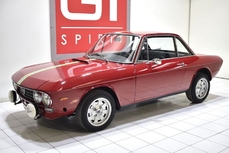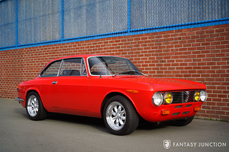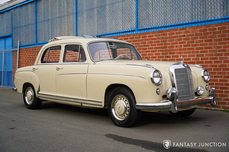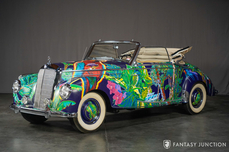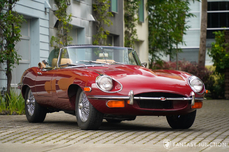Lancia Fulvia 1300cc Inline Four 1966
Allgemeine Beschreibung :
1966 Lancia Fulvia Sport Zagato
Chassis Number – 818.132.001155
Engine Number – 818.302*017859*
Exterior Color –Blue Mendoza
Interior Color - Red
Engine Type – 1.3L V4 OHC
Gearbox – 4-speed manual
Current Miles – 100,507 miles TMU
Features of This Example
Final example of just 202 alloy bodied 1.2L Sport Zagato Lancias built
Tastefully upgraded to 1.3L engine (early 1968 series V4 engine)
Ordered brand new by Oscar-nominated film editor Hugh Lloyd
Correct plexiglas headlight cover car as new from the factory
General History
An italian sports car with Zagato coachwork, disc brakes, and twin cam engine, the Fulvia Zagato put the finishing touch on an era of superlative coachbuilt sports cars. Long regarded for their exceptional craftsmanship, innovative engineering, and cost-no-object attention to detail, prior to Fiat involvement, Lancia built elegant and refined performance cars with few rivals.
Among the last of the pre-FIAT cars, the unibody front-drive Fulvia was designed with a dual overhead cam narrow angle common cylinder head V4 engine. Dunlop disc brakes on all four corners provided stopping power, along with a host of further technical features. In 1967, Road and Track magazine described the car as "a precision motorcar, an engineering tour de force". The Fulvia was surprisingly quick for its displacement and proved to be formidable in both rally and circuit racing. The rare and special Zagato coupe bodywork, available in limited quantities, provided excellent visibility and a surprising amount of space for larger drivers. The first of the Zagato series cars were hand formed with all alloy construction with 1.2L engines. This lightweight combination and handmade quality make these earliest examples the most sought after today.
Owner History
With an unbroken chain of known ownership beginning with the original owner, Oscar nominated film editor Hugh Lloyd, this Sport Zagato was manufactured in 1966 and first registered to Llyod on plate TI3132 January 16, 1967, a resident of Turin, Italy. Per his order, the car was outfitted with UK instrumentation, and later Lloyd had Dinitrol rustproofing applied to the chassis, fitting a set of 5 FPS alloy wheels, which are still on the car today. A car enthusiast, Llyod was a member of the Automobile Club D’Italia, announced by the Roma division windows sticker still on the car today.
On February 3, 1970 Llyod imported the car to the UK, registering it on export plates EE43470, later registering it on EPE199J. In 1983 Llyod sold the car to Goodwood racer Chris Gawne who updated the engine to the more desirable 1.3L variant outfitted with Dellorto carburetors. The car changed hands a few times before it came into the collection of BaT enthusiast Alex_V who offered it for sale on BaT in February 2015 https://bringatrailer.com/list... At that time, the car showed 99,000 miles, the majority of which were accrued under Lloyd’s ownership.
Ownership history includes:
Hugh Lloyd – 1966-1983
Chris Gawne – 1983-1999
Roger Mills – 1999-2002
N. Linguard – 2002-2005
Richard Thorne – 2005-2007
Jaqueline Gawne – 2007-2013 (wife of second owner)
Clive Winstone – 2013-2014 (classic car dealer)
Alex Vazaios – 2014- 2015
Cosmetic Overview
Today, this Sport Zagato presents in very attractive condition with glossy paint applied over handsomely finished aluminum body work. The chrome and various trim are all in very good condition, particularly the exceptionally hard to find grille and chrome plated headlight bezels along with the rare plastic headlight covers. A pair of bumper mounted Carello driving lamps are also in place, likely period mounted, as earlier photos show the car with chrome caps over the bolt holes. The lenses, glass, and delicate “Fulvia Sport” script across the hood announce both the Italian heritage and design excellence, while Zagato coachwork badges confidently flank both front fenders. The desirable later series cast alloy wheels were added in period and today are in excellent shape, adding a sporting period-correct enhancement to the car, giving it great stance. Many of these cars often sit a bit high in the rear, however the stance in this example is visually satisfying, giving the car just the right amount of forward rake.
The color-contrasting interior is excellent overall, reupholstered in correct red with appropriate headliner and rear carpet treatment done in high quality materials. The low-profile bucket seats are in excellent condition with comfortable bolsters and good side support. The door panels and headliner are in very nice condition. The wood dash trim is properly finished, housing the correct instrumentation, clock, and rare radio delete plate with Fulvia script. The gauges and controls feature nice color and contrast, excellent trim, and a correct Lancia badged wood rim steering wheel. The correct ribbed and fitted rubber floor mats are similarly nice as is the rubber booted shifter. Lifting the rear hatch, the storage space area is nicely finished and properly trimmed with space for soft weekend luggage. Additionally, the rear hatch can be electronically raised and lowered via a dash switch, allowing cabin ventilation – among one of the more notable innovations of this model. The spare tire is accessed via a drop-down rear fascia body panel and contains a matching alloy wheel, spare tire hold down, jack and partial tools.
The engine compartment is accessed via early series side hinged hood tilting open to display the angled V4 engine. Both the engine and engine compartment are very nicely prepared, with proper finishes, original components, and properly sorted hardware. The engine is a correct type 303 1.3 L series engine, outfitted with desirable Dellorto carburetors. The engine compartment is correctly finished with original colors and textures including the Lancia black crinkle paint on the twin cam head, original air cleaner housing, proper hoses, and correct green spark plug wires.
The car runs and drives well, starting easily, revving freely, and shifting smoothly. The disc brakes are very effective for this period and the chassis has a nice coherent and comfortable feel that is perfectly suited for mountain roads and spirited driving. The Fulvia is known for light and communicative steering, delivering precise and responsive results – certainly one of the top characteristics of this model.
This is an excellent opportunity to acquire a rare, technically interesting, and entertaining classic Lancia Sport Fulvia with unique all alloy hand formed Zagato coachwork. Extraordinarily rare in the United States, Fulvias have robust US based parts and service availability and can be easily serviced by mechanically minded enthusiasts, making them ideal usable vintage sports cars with unique construction, satisfying performance, and exceptional design traits.
Included with this car
Extensive original documentation supporting the original owner purchase, import documentation, automobile club card, UK ownership from first owner, FIVA identity card, interior restoration invoice, older service invoices, a matching alloy spare tire, spare tire hold down, jack, and partial tools accompany the car.
Walkaround video: https://youtu.be/1oYOxz97fY0Driving video: https://youtu.be/KcFu87PnWVc
https://fantasyjunction.com/inventory/1966-lancia-fulvia-sport-zagato/overview
1966 Lancia Fulvia 1300cc Inline Four is listed verkauft on ClassicDigest in Emeryville by Fantasy Junction for Preis nicht verfügbar.
Fakten der Auto
Karosserietyp : Auto Marke : Lancia Modell : Fulvia Ausführung : 1300cc Inline Four Hubraum : 1.3 Modelljahr : 1966 Lage : Emeryville Fahrzeug Anmeldung : Normal
Verkauft
Angaben Zum Verkäufer
Verkauft
People who viewed this Lancia Fulvia also viewed similar Lancia listed at ClassicDigest
Other cars listed for sale by this dealer
über Lancia
Ah, Lancia, die italienische Marke, die auf dem schmalen Grat automobiler Brillanz getanzt hat! Lass mich dich auf eine Reise durch die fesselnde Geschichte von Lancia mitnehmen, einer Marke, die Leidenschaft, Innovation und Rallye-Erfolg verkörpert.Akt 1: Die Frühen Jahre (1906-1920er)
Lancia wurde 1906 von Vincenzo Lancia gegründet, einem Ingenieursgenie mit einer Vorliebe für das Außergewöhnliche. Die Marke erlangte schnell einen Ruf für ihre präzise Ingenieurskunst und innovative Herangehensweise. Der Lancia Alpha, 1907 eingeführt, war das erste Auto mit einem schmalen V4-Motor und setzte den Ton für Lancias Einsatz für technische Exzellenz.
Akt 2: Innovation im Zentrum (1930er-1950er)
Die 1930er Jahre sahen Lancia die Grenzen der Innovation mit Modellen wie dem Lambda ausloten, dem ersten Auto mit selbsttragender Monocoque-Chassis. Der in den 1930er Jahren eingeführte Aprilia präsentierte wegweisende Aerodynamik und einen V4-Motor und festigte Lancias Ruf als Pionier.
Akt 3: Eleganz der Nachkriegszeit (1950er-1960er)
Nach dem Zweiten Weltkrieg begeisterte Lancia weiterhin mit Modellen wie dem Aurelia, dem ersten Serienauto mit einem V6-Motor. Es verband Leistung mit Komfort und Eleganz. Der Flaminia folgte und verkörperte Luxus und fortschrittliche Technik.
Akt 4: Rallye-Dominanz (1970er-1980er)
Lancia hat sich mit einer beispiellosen Rallye-Geschichte einen Platz in der Motorsportgeschichte gesichert. Der Lancia Stratos, ein keilförmiges Wunder, dominierte die Rallyeszene in den 1970er Jahren und holte von 1974 bis 1976 drei aufeinanderfolgende Rallye-Weltmeisterschaften. Der Delta Integrale, in den 1980er Jahren eingeführt, setzte diese Rallye-Herrschaft mit mehreren Meisterschaften fort.
Akt 5: Herausforderungen und Widerstandsfähigkeit (1990er-2000er)
Das späte 20. Jahrhundert brachte finanzielle Herausforderungen für Lancia mit sich, was zu Zusammenarbeiten mit anderen Automobilherstellern führte. Trotz der Schwierigkeiten führte Lancia Modelle wie den Thesis und den Ypsilon ein, die den Einsatz für Stil und Substanz zeigten.
Akt 6: Neuerfindung im 21. Jahrhundert (2010er-Heute)
In den 2010er Jahren konzentrierte sich Lancia auf die Ypsilon als Hauptmodell, um die Markenstrategie neu auszurichten. Obwohl die Produktionszahlen zurückgingen, behielt die Marke ihren Ruf für unverwechselbares Design und Komfort bei.
Epilog: Ein Erbe von Leidenschaft und Innovation
Lancias Geschichte ist eine von Leidenschaft, Innovation und Motorsporterfolg. Die Marke, mit ihren bahnbrechenden Designs, technologischen Fortschritten und Rallyetriumphen, hat einen unauslöschlichen Eindruck in der Automobilwelt hinterlassen. Lancia mag in den letzten Jahren Herausforderungen gegenüberstehen, aber ihr Erbe lebt weiter, gefeiert von Enthusiasten, die die Magie in jedem Lancia-Werk erkennen
